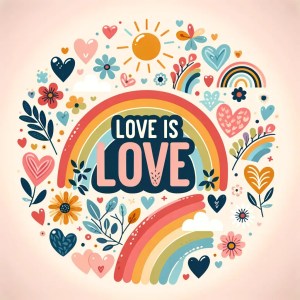- Introduction: The Dynamic Landscape of Solo Polyamory
- What is Solo Polyamory: Redefining Intimacy
- The Genesis and Evolution of Solo Polyamory: Tracing the Roots of Autonomous Intimacy
- The Perplexity of Solo Poly Life: A Balancing Act
- Societal Implications and Public Perception: Challenging and Shaping Norms
- Strategies for Flourishing in Solo Polyamory:
- Pertinent Statistics:
- The Solo Polyamory Experience: A Spectrum of Perspectives
- Conclusion: The Odyssey of Solo Polyamory
Introduction: The Dynamic Landscape of Solo Polyamory
In the realm of romantic relationships, solo polyamory emerges as a vibrant tapestry woven with the threads of independence and intimate connections. This distinct form of non-monogamy defies the traditional confines of relationships by eschewing a primary partner, thereby crafting a mosaic of emotional and logistical layers that beckon exploration. The solo polyamorous journey, while liberating, is often strewn with a web of complexities that can bewilder even the most intrepid hearts. Through a kaleidoscope of insights, this guide aims to illuminate the path for those navigating the labyrinth of solo polyamory, enriching the tapestry with new threads of knowledge and strategies for a fulfilling journey.

What is Solo Polyamory: Redefining Intimacy
Solo polyamory — colloquially known as “solo poly” — is an avant-garde relationship style that champions self-sufficiency alongside multiple romantic bonds. It stands in stark contrast to traditional monogamy, eschewing the conventional milestones of cohabitation, financial interdependence, and marriage. Practitioners of solo poly cherish their autonomy, reveling in a journey of self-discovery and empowerment that transcends societal expectations of coupledom.
The Genesis and Evolution of Solo Polyamory: Tracing the Roots of Autonomous Intimacy

Tracing the Roots:
The journey of solo polyamory is as ancient as it is revolutionary, with its roots deeply embedded in the annals of human history. The practice of maintaining multiple romantic relationships with a degree of independence has been documented in various forms across different cultures and eras. Indigenous societies across the globe, from the polygynous compounds of Africa to the polyandrous households of Tibet, have long recognized the legitimacy of forming multiple romantic bonds. However, the iteration we recognize today as solo polyamory draws its most direct lineage from the free love movement of the 19th century, which began to question the state’s role in regulating personal affairs such as marriage.
As the tendrils of this movement reached into the 20th century, they intertwined with the burgeoning sexual revolution of the 1960s and 70s. This period of seismic social change challenged the very fabric of conventional relationships, advocating for sexual freedom and the normalization of consensual non-monogamy. These decades of liberation and experimentation set the stage for the emergence of solo polyamory as a distinct identity within the non-monogamy spectrum, providing a framework for relationships that valued autonomy as much as intimacy.
A Chronology of Non-Monogamy to Solo Poly:
The evolutionary timeline of solo polyamory is marked by a series of pivotal moments and influential figures. The lexicon of non-monogamy itself was enriched by the coining of “polyamory” in the 1980s, a term attributed to Morning Glory Zell-Ravenheart. This was a significant moment, as it provided a label for a practice that many had been engaging in but lacked the language to describe. The 1990s saw a further surge in the visibility of polyamorous relationships, bolstered by the LGBTQ+ rights movement’s fight for societal acceptance of diverse relationship models.
The advent of the internet and the subsequent rise of digital culture in the late 20th century proved to be a catalyst for the solo polyamory movement. Online forums and communities began to form, creating spaces where individuals could share experiences, establish guidelines, and forge connections. Key texts like “The Ethical Slut,” published in 1997 by Dossie Easton and Janet Hardy, became cornerstones for those exploring non-traditional relationship paths. These resources offered guidance and validation, marking solo polyamory as a lifestyle that was not only viable but also rich with potential for personal fulfillment.

The Modern Solo Polyamory Movement:
In today’s digital age, solo polyamory is experiencing an unprecedented level of evolution and acceptance. A new generation of solo polyamorists has emerged, individuals who are not just practicing relationship autonomy but are also vocally advocating for their lifestyle. The current movement is a tapestry of past and present, weaving together the threads of historical non-monogamy with the modern capabilities of digital communication.
Social media platforms, blogs, and online discussion groups serve as the contemporary agora for solo polyamorists, places where they can exchange ideas, offer support, and rally for recognition. The movement is characterized by its fluidity, eschewing rigid definitions and embracing an adaptive approach to relationship structures. This flexibility reflects the diverse needs and desires of its practitioners, allowing for a personalized interpretation of what it means to live and love autonomously.
The ongoing evolution of solo polyamory is not just a testament to the resilience and adaptability of the movement but also an indicator of broader societal shifts. As more people seek to define relationships on their own terms, solo polyamory stands as a beacon of self-determination and personal agency in the realm of intimate connections. It is a movement that continues to grow, not only in numbers but also in the depth and richness of its collective experience.

The Perplexity of Solo Poly Life: A Balancing Act
Embarking on a solo polyamorous life is akin to becoming a skilled juggler, where one’s hands must deftly balance the spheres of multiple relationships and personal freedom. The intricacy lies in the absence of societal blueprints, propelling individuals to navigate uncharted territories with grace. It demands a mastery of communication, an unwavering respect for boundaries, and an adeptness in time management — skills that form the cornerstone of this unique lifestyle.
Societal Implications and Public Perception: Challenging and Shaping Norms
Navigating Social Norms:
In the dominantly monogamous landscape of contemporary society, solo polyamory is often met with misconceptions and biases. Practitioners navigate a complex network of social interactions where their relationship choices may be misunderstood or criticized. To counteract this, many solo polyamorists engage in open dialogues to demystify their lifestyle, offering personal insights into the ethical and consensual nature of their relationships. This proactive communication helps to dismantle stereotypes and fosters a more nuanced understanding of non-monogamy.
Activism plays a vital role in this educational process. Advocates work tirelessly to promote inclusivity and normalize diverse relationship structures through various platforms, including public speaking engagements, literature, and social media campaigns. These efforts are not just about gaining acceptance; they’re about celebrating the spectrum of human relationships and recognizing solo polyamory as a legitimate choice among them.

The Impact on Family and Community:
Solo polyamory introduces a unique dynamic to family structures and community engagement, challenging traditional notions of both. Within family settings, solo polyamorists often bring a collaborative approach to child-rearing, where children benefit from a wider network of adult support. These extended family models can provide a rich social environment, though they require clear boundaries and communication to navigate successfully.
Communities also evolve in the presence of solo polyamory, as it can alter the dynamics of social support systems and collective engagement. Solo polyamorists may contribute to a more fluid and flexible understanding of community, where the lines between friend, partner, and family blur, creating inclusive spaces that accommodate a range of relationships and interactions.
Representation in Media and Culture:
The representation of solo polyamory in mainstream media has been a mixed bag, with portrayals ranging from the sensational to the sensitive. While early depictions often relegated polyamorous characters to the realm of the exotic and scandalous, recent years have seen a shift towards more respectful and authentic representations. Television shows like “You Me Her” and “Polyamory: Married & Dating” have brought polyamorous relationships to the forefront, offering viewers a glimpse into the complexities and joys of these arrangements.
In literature and online content, solo polyamory is increasingly discussed with the nuance and depth it deserves. Blogs, podcasts, and books written by those who practice solo polyamory serve not only as resources for the community but also as educational tools for the wider public. These works provide a counter-narrative to the pervasive monogamy-centric stories in our culture, illustrating that love is not limited to a single format.
Personal Narratives and Community Voices: Celebrating Diverse Experiences

Diverse Experiences Within Solo Polyamory:
The solo polyamory community is as diverse as it is vibrant, encompassing individuals from all walks of life. These personal narratives highlight the myriad ways in which people engage with solo polyamory. Some narratives recount the journey of self-discovery and personal autonomy that solo polyamory facilitates, while others focus on the challenge of finding balance among multiple loving relationships without a primary partner. These stories are testament to the flexibility and adaptability of solo polyamory, as well as its capacity to foster profound connections and a sense of personal fulfillment.
Community Support and Resources:
For those practicing or curious about solo polyamory, there is a wealth of resources available. Online forums like Reddit’s r/polyamory and websites such as More Than Two.com provide spaces for discussion, advice, and solidarity. Books such as “The Ethical Slut” and “More Than Two: A Practical Guide to Ethical Polyamory” are considered foundational texts, offering guidance on navigating the complexities of non-monogamous relationships. Meetup groups and conferences, such as Polytopia and RelateCon, offer in-person opportunities for education and community building.
Voices of Change: Interviews and Essays:
The solo polyamory movement is driven by voices that seek to articulate its nuances and advocate for its recognition. Interviews with figures like Elisabeth Sheff, an expert on polyamory, and Franklin Veaux, a prominent author and blogger on non-monogamy, shed light on the evolution of solo polyamory and its future trajectory. Essays in online publications such as The Polyamorous Times explore the intersectionality of solo polyamory with issues of race, sexuality, and gender, enriching the dialogue around the movement and pushing for a more inclusive society.

Strategies for Flourishing in Solo Polyamory:
- Communication as the Cornerstone: Establishing and maintaining open channels of communication with all partners is vital. It’s the bedrock upon which trust, and understanding are built.
- Celebrating Independence: Solo polyamory is a testament to the celebration of one’s autonomy. It’s about embracing personal choices while fostering mutual respect for the independence of all involved.
- Time Management Mastery: The art of managing multiple romantic engagements without compromise requires impeccable planning. Embrace digital tools and calendars to orchestrate your commitments harmoniously.
- Emotional Fortitude: In a world that often lionizes monogamy, solo poly individuals may encounter waves of isolation. Cultivating a robust support network is crucial to weather such emotional storms.
- Vigilance in Sexual Health: The spectrum of sexual health takes on heightened significance within solo polyamory. A commitment to regular health screenings and candid discussions about safe sex practices is indispensable.
- Navigating Legalities and Finances: Solo polyamory can introduce unique legal and financial challenges. An understanding of these aspects, perhaps guided by legal counsel, is essential for safeguarding individual rights and assets.
Pertinent Statistics:
Despite the scarcity of extensive statistical data on solo polyamory, a 2016 study in the Journal of Sex & Marital Therapy revealed that around 20% of single adults have explored consensual non-monogamy. This statistic signifies a burgeoning recognition and incorporation of diverse relationship models in modern society.

The Solo Polyamory Experience: A Spectrum of Perspectives
The narrative of solo poly individuals is a mosaic of self-actualization and growth, juxtaposed with the challenges of navigating societal misconceptions and the emotional intricacies of multiple partnerships. The solo poly experience is as multifaceted as the individuals themselves, each story a unique blend of personal values and aspirations.
Conclusion: The Odyssey of Solo Polyamory
Solo polyamory is not a universal solution to relationship quests but an individualized odyssey that offers a cornucopia of relational experiences. By weaving together, the principles of clear communication, unbridled autonomy, and emotional resilience, those who walk the solo poly path can chart a course through its complexities. Regardless of where one stands on the solo polyamory spectrum — whether at the threshold or further along the path — the journey promises a continuous evolution of learning and self-discovery. It is an invitation to redefine the essence of relationships and to forge an experience that is as enriching as it is profound.
Make sure you join our forum and start a conversation, today! Also check out our free Toolkit!















